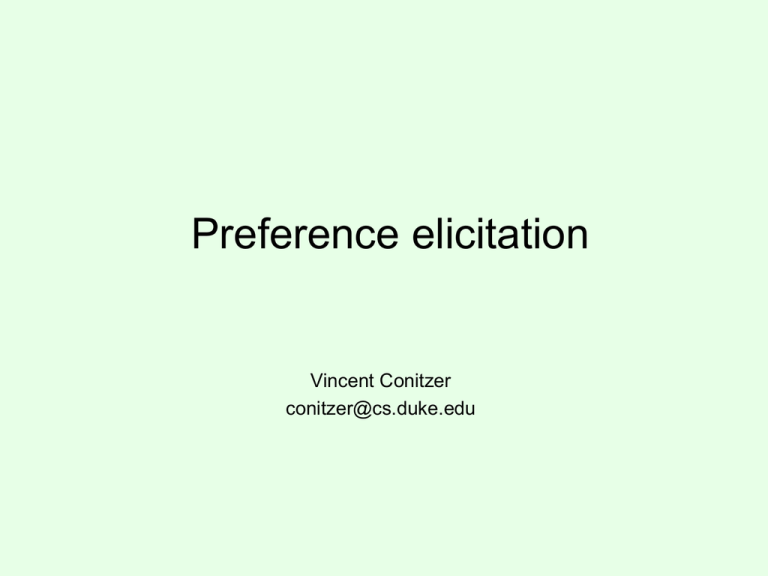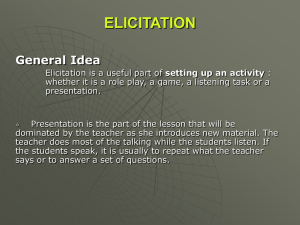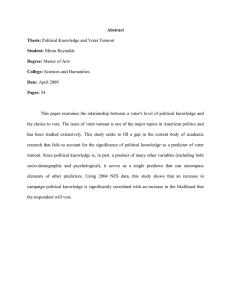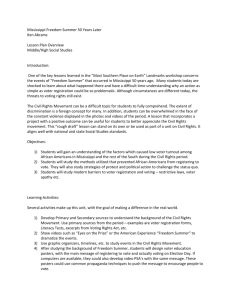Preference elicitation Vincent Conitzer
advertisement

Preference elicitation
Vincent Conitzer
conitzer@cs.duke.edu
Excessive communication
• So far we have focused on revealing full preferences; often not
practical
• Rate/rank all the songs you’ve ever heard
• Rate/rank all possible budget allocations
• …
• Some ways to address this:
• Directly model underlying structure
• Directly express preferences over aspects of song
(genre, instruments), individual items on the budget, …
• Need to worry about interactions (voting in combinatorial
domains)
• Preference elicitation: ask voters selected queries about
preferences, avoid asking for irrelevant information
Preference elicitation (elections)
“
?”
>
“yes”
“
>
?”
“yes”
“no”
center/organizer/
…
“most
preferred?”
“
“
>
”
wins
?”
Representing elicitation protocols
voter 1: do you prefer a to b?
yes
no
voter 2: do you prefer
a to c?
yes
no
a wins
yes
voter 1: do you
prefer a to c?
voter 1: do you
prefer a to c?
yes
voter 2: do you prefer
c to b?
no
c wins
yes
no
a wins
c wins
yes
c wins
no
voter 1: do you
prefer c to b?
b wins
no
b wins
• Can choose to hide information from agents, but only
insofar as it is not implied by queries we ask of them
• (What’s inefficient about the above protocol?)
Strategic issues
• Consider the following protocol for eliciting a plurality winner
with three voters
•
•
•
•
Ask voter 1 for her most-preferred alternative t1
Ask voter 2 for his most-preferred alternative t2
If t1 = t2 then declare it the winner
Otherwise, ask voter 3 if one of t1 or t2 is her most-preferred
alternative
• If yes, then declare that one the winner
• If no, then toss a coin to decide between t1 and t2
• What opportunity for strategic manipulation does this provide
voter 3?
Two possible goals
(Assume truthful reporting for the rest of this lecture)
1. Ask queries until we know the true winner under a
given common voting rule (e.g., plurality)
2. Keep asking queries until we’ve found an
alternative that is “good enough”
(allows us to get away with fewer queries)
(Note: 2 will still correspond to some voting rule)
Elicitation algorithms for given rules
• Design elicitation algorithm to minimize queries
for given rule
• What is a good elicitation algorithm for STV?
• What about Bucklin?
An elicitation algorithm for the Bucklin
voting rule based on binary search
[C. & Sandholm 05]
• Alternatives: A B C D E F G H
• Top 4?
{A B C D}
{A B F G}
{A C E H}
• Top 2?
{A D}
{B F}
{C H}
• Top 3?
{A C D}
{B F G}
{C E H}
Total communication is nm + nm/2 + nm/4 + … ≤ 2nm bits
(n number of voters, m number of candidates)
Lower bounds on communication
• Communication complexity theory can be used
to show lower bounds
– “Any elicitation algorithm for rule r requires
communication of at least N bits (in the worst case)”
• Voting [C. & Sandholm 05]
– Bucklin requires at least on the order of nm bits
– STV requires at least on the order of n log m bits
• Natural algorithm uses on the order of n(log m)2 bits
How do we know that we have found the
best elicitation protocol for a mechanism?
• Communication complexity theory:
Agent 1 0
1
agent i holds input xi, agents must
communicate enough information
to compute some f(x1, x2, …, xn)
1 0
1
Agent 2 0
• Consider the tree of all possible
communications:
f=0 f=1 f=1 f=0
• Every input vector goes to some
x1, x2
x1’, x2
leaf
x1’, x2’
• If x1, …, xn goes to same leaf as x1’, …, xn’ then so must any mix of them
(e.g., x1, x2’, x3, …, xn’)
• Only possible if f is same in all 2n cases
• Suppose we have a fooling set of t input vectors that all give the same
function value f0, but for any two of them, there is a mix that gives a
different value
• Then all vectors must go to different leaves tree depth must be ≥ log(t)
Example: plurality
•
•
•
•
•
•
•
A fooling set:
a, a, b, b, c, c, a
a, a, c, c, b, b, a
b, b, a, a, c, c, a
b, b, c, c, a, a, a
c, c, a, a, b, b, a
c, c, b, b, a, a, a
• Not a fooling set:
• a, a, a, b
• c, a, a, a
any two can be mixed to
get a different winner,
e.g., a, a, b, b, b, b, a
a wins on all of
these
can be extended to show an
order n log m lower bound
(best possible)
Finding a winner that is
“good enough”
• If we have elicited enough information to determine
that an alternative is a necessary winner, we can stop
• But what if we want to stop earlier?
• Suppose we have some measure of welfare (e.g.,
Borda score) and partially elicited preferences
• Max regret of an alternative a:
How much worse than the best alternative could a’s
welfare still be?
• Minimax regret alternative: an alternative that
minimizes maximum regret
• Then ask queries to try to quickly reduce minimax
regret
• [Lu & Boutilier 2011]
Example (Borda)
•
•
•
•
•
Partial profile:
Voter 1: a>b>c
Voter 2: a>b
Voter 3: c>a
Max regret for a: 1 (against c, if vote 2 is c>a>b and
vote 3 is c>b>a)
• Max regret for b: 4 (against a, if vote 2 is a>c>b and
vote 3 is c>a>b)
• Max regret for c: 3 (against a, if vote 2 is a>b>c and
vote 3 is c>a>b or b>c>a; or against b, if vote 2 is
a>b>c and vote 3 is b>c>a)
• a is the minimax regret alternative




